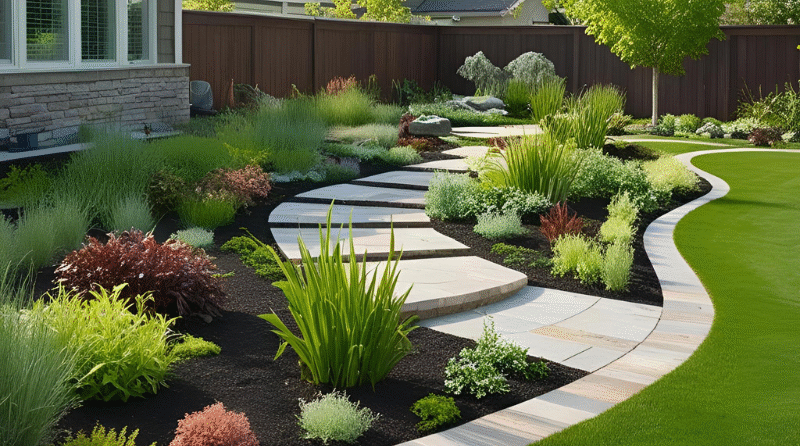14 Sustainable Landscaping Tips for a Healthier Yard
Creating a sustainable landscape isn’t just about aesthetics — it’s about reducing waste, conserving water, and supporting your local environment. From planting native species to reducing lawn space, eco-friendly landscaping is a smart and responsible way to maintain your yard.
Here are 14 actionable landscaping ideas to help make your yard greener, healthier, and more sustainable.
1. Choose Native Plants
Native plants are resilient, low-maintenance, and require less water and fertilizers. They also provide food and shelter for pollinators and beneficial insects.
Tip: Group native species by light and water needs for best results.
2. Install a Drip Irrigation System
Drip irrigation delivers water directly to the root zone, minimizing evaporation and saving water. It’s more efficient than sprinklers and ideal for flower beds and garden areas.
3. Build a Rain Garden
Rain gardens capture runoff from roofs or driveways and naturally filter pollutants. They also reduce the burden on stormwater systems while supporting biodiversity.
4. Plant Shade Trees Strategically
Trees not only provide shade but also reduce the need for AC in summer months. Choose drought-tolerant varieties that suit your region’s climate.
If you’re planting near older trees, you might want to consider tree cutting and pruning to allow new growth to flourish and to maintain tree health.
5. Use Permeable Hardscapes
Replace concrete paths and driveways with permeable materials like gravel, stone, or pavers that allow water to soak into the ground, preventing runoff.
6. Compost Yard and Kitchen Waste
Turn leaves, lawn clippings, and kitchen scraps into rich compost. Composting reduces landfill waste and improves soil structure.
After a season change, it’s ideal to start with a thorough property cleanup to gather excess yard waste and organic matter.
7. Grow a Pollinator-Friendly Garden
Pollinators are vital to our ecosystem. Use flowers like bee balm, lavender, and milkweed, and avoid harmful pesticides.
8. Mulch to Retain Moisture
Organic mulch keeps soil cool and moist, suppresses weeds, and improves soil fertility as it breaks down.
Combining mulch with rock and mulch borders or fabric installation underneath can significantly improve moisture retention and weed control.
9. Harvest Rainwater
Rain barrels or underground cisterns let you reuse rainwater for irrigation, saving water and reducing bills.
10. Replace Lawn with Low-Maintenance Alternatives
Swap grass for native ground covers or ornamental grasses to reduce mowing and watering.
You can also improve soil health with core aeration and overseeding and fertilization, which promote stronger root systems and drought resistance.
11. Use Solar Landscape Lighting
Solar-powered garden lights are energy-efficient, cost-effective, and easy to install without wiring.
12. Encourage Beneficial Insects
Ladybugs and lacewings help naturally control pests. Avoid broad pesticides and provide shelter with diverse plantings.
13. Add Windbreaks
Using hedges, shrubs, or ornamental grasses can reduce wind damage, support wildlife, and improve microclimates.
Routine hedge & bush trimming helps keep these natural barriers effective and aesthetically pleasing.
14. Practice “No-Dig” Gardening
Avoid tilling to maintain soil integrity and microbial health. Use compost and mulch layers to suppress weeds and feed your soil.
If starting from scratch, consider sod rip-outs and rototilling to prepare your landscape before layering with organic matter.
Final Thoughts: Landscaping for the Planet
An eco-friendly yard doesn’t have to be high-maintenance or expensive. By making small, intentional choices — like using mulch, planting natives, or composting — you can create a beautiful, resilient outdoor space that benefits both you and the planet. Start where you are, use what you have, and let your landscape work in harmony with nature.
FAQs:
Q1: What are some benefits of eco-friendly landscaping?
Eco-friendly landscaping saves water, reduces maintenance costs, supports wildlife, improves soil health, and creates a more sustainable yard.
Q2: What are the easiest eco-friendly changes I can make in my yard?
Start with native plants, use organic mulch, and collect rainwater. These small changes make a big impact without requiring a full yard redesign.
Q3: Does eco-friendly landscaping require a big investment?
Not necessarily. Many strategies like composting, using mulch, or trimming trees smartly are low-cost and offer long-term savings.
Q4: Can I still have a lawn with eco-friendly landscaping?
Yes, but consider downsizing the lawn or using drought-tolerant grasses. Practices like overseeding, core aeration, and fertilization can make your lawn healthier and more sustainable.
Q5: How do I get started if my yard needs a lot of cleanup?
Begin with a thorough seasonal cleanup to remove dead branches, leaves, and clutter. This gives you a fresh canvas to begin your eco-friendly upgrades.


